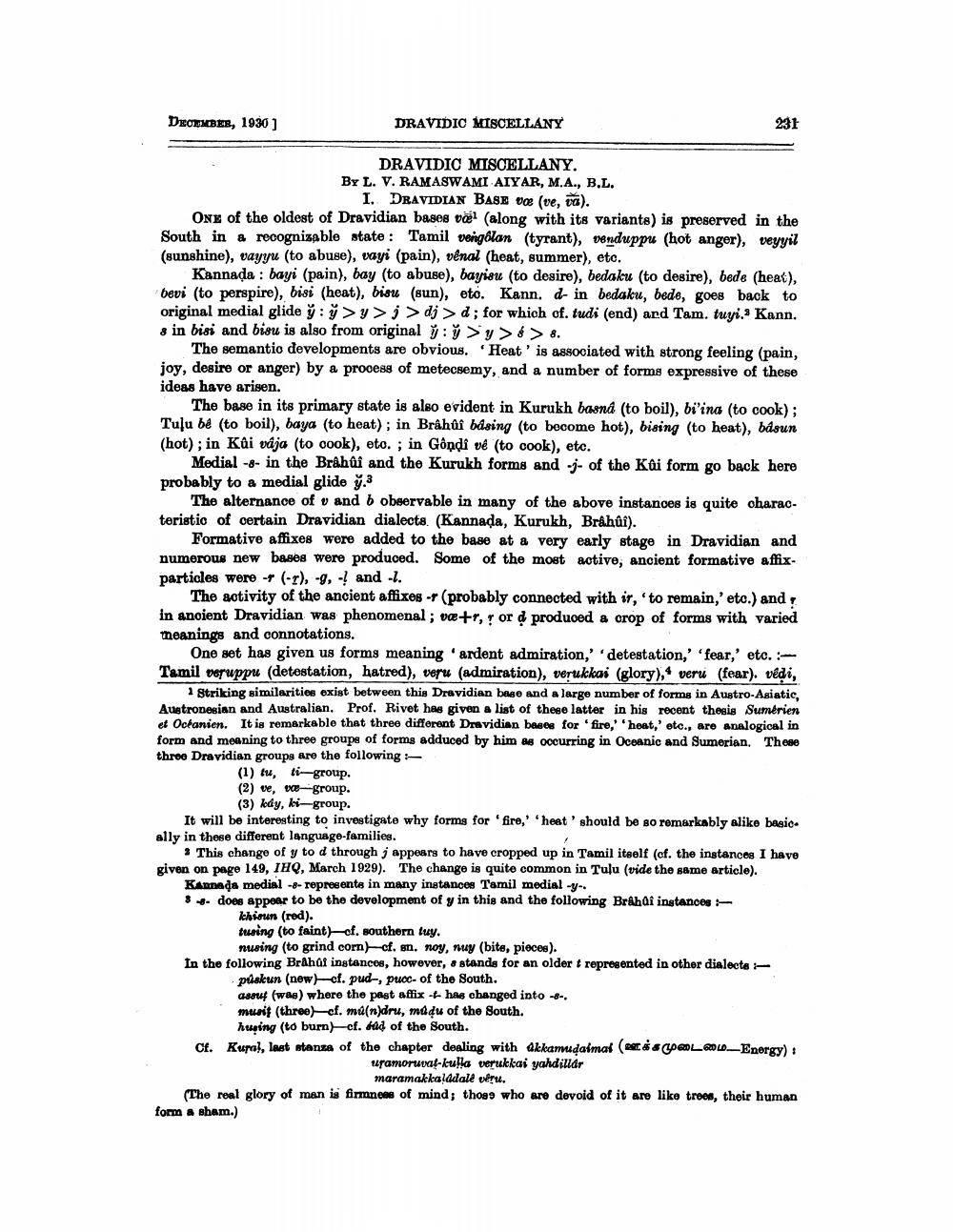________________
DECEMBER, 1930 ]
DRAVIDIC MISCELLANY
231
DRAVIDIC MISCELLANY. By L. V. RAMASWAMI AIYAR, M.A., B.L.
I. DRAVIDIAN BASE voe (ve, va). ONE of the oldest of Dravidian bases voel (along with its variants) is preserved in the South in a recognizable state: Tamil vengolan (tyrant), venduppu (hot anger), veyyil (sunshine), vayyu (to abuse), vayi (pain), vénal (heat, summer), etc.
Kannada : bayi (pain), bay (to abuse), bayisu (to desire), bedaku (to desire), bede (heat), bevi (to perspire), bisi (heat), bisu (sun), eto. Kann, d- in bedaku, bede, goes back to original medial glide ý:>y> ; dj >d; for which of, tudi (end) and Tam, tuyi.. Kann. sin bisi and bisu is also from original y : y >y> > 8.
The semantic developments are obvious. Heat' is associated with strong feeling (pain, joy, desire or anger) by a process of metecsemy, and a number of forms expressive of these ideas have arisen.
The base in its primary state is also evident in Kurukh basna (to boil), bi'ina (to cook); Tuļu bé (to boil), baya (to heat); in Brâhui bising (to become hot), bising (to heat), bdsun (hot); in Kui vaja (to cook), eto. ; in Gôndi ve (to cook), etc.
Medial -8- in the Brahûî and the Kurukh forms and -j- of the Kâi form go back here probably to a medial glide y.3
The alternance of v and b observable in many of the above instances is quite characteristio of certain Dravidian dialects (Kannada, Kurukh, Brahûf).
Formative affixes were added to the base at a very early stage in Dravidian and numerous new bases were produced. Some of the most active, ancient formative affixparticles were -4 (-1), -9, - and -1.
The activity of the ancient affixes - (probably connected with it, to remain,' etc.) and in anoient Dravidian was phenomenal; væ+r, or d produoed a crop of forms with varied meanings and connotations.
One set has given us forms meaning 'ardent admiration,' detestation,' 'fear,' etc. :Tamil veruppu (detestation, hatred), veru (admiration), verukkai (glory), veru (fear). védi,
1 Striking similarities exist between this Dravidian base and a large number of forma in Austro-Asiatic, Austronesian and Australian, Prof. Rivet has given a list of these latter in his recent thesis Sumérien et Océanien. It is remarkable that three different Dravidian bases for 'fire,' 'host, oto., are analogical in form and meaning to three groups of forms adduced by him as occurring in Oceanic and Sumerian. These three Dravidian groups are the following
(1) tu, tigroup. (2) ve, 16-group.
(3) kody, ki-group. It will be interesting to investigate why forms for 'fire," "heat' should be so remarkably alike basic. ally in these different language-families.
This change of y to d through j appears to have cropped up in Tamil itself (cf. the instances I have given on page 149, IHQ, March 1929). The change is quite common in Tulu (vide the same article).
Kannada medial -8- represente in many instances Tamil medial -y84. does appear to be the development of y in this and the following Brahi instances >
kehioun (red). tusing (to faint)of. southern luy.
nusing (to grind corn)cf. sn, noy, nuy (bite, pieces). In the following Brahof instancos, however, a stands for an older represented in other dialects -
puskun (newcf. pud, pucc- of the South. assut (was) where the past affix -- has changed into -:-. murit (three)cf. mü(n)dru, modu of the South.
huping (to burn)cf. fuld of the South. Cf. Kupal, laat stanza of the chapter dealing with Okkamudaimat (ex S RL.20.-Energy).
uramoruvat-kulla verukkai yahdillar
maramakkaladali véru. (The real glory of man is firmness of mind; those who are devoid of it are like troes, their human form a sham.)




